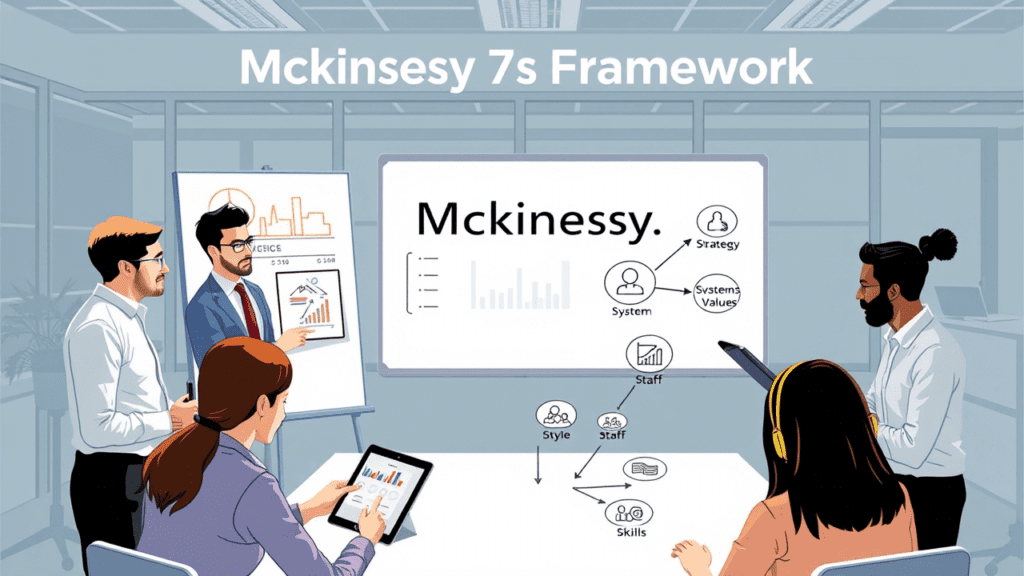Introduction
In today’s fast-paced business world, companies need a structured approach to align their internal elements for maximum efficiency and success. The McKinsey 7S Framework, developed by consultants at McKinsey & Company, is a powerful tool that helps businesses assess and optimize seven key internal factors:
- Strategy
- Structure
- Systems
- Shared Values (or Superordinate Goals)
- Style (Leadership)
- Staff
- Skills
This model ensures that all aspects of an organization work in harmony to achieve long-term goals. In this blog post, we’ll break down each of the 7S elements, explain how they interconnect, and provide real-world examples to help you apply this framework to your business.
1. Strategy: Your Roadmap to Success
Definition: The plan of action to achieve competitive advantage and long-term objectives.
Key Questions:
- What is our business goal?
- How do we differentiate ourselves from competitors?
- Are our resources aligned with our strategy?
Example:
- Apple’s Strategy: Innovation-driven, premium pricing, and ecosystem integration (iPhone, Mac, Apple Watch).
Tip: Regularly review and adjust your strategy based on market changes.
2. Structure: How Your Organization is Designed
Definition: The way teams, departments, and hierarchies are organized.
Key Questions:
- Is our organizational structure flat or hierarchical?
- Does it support efficient communication?
- Are roles and responsibilities clearly defined?
Example:
- Google’s Structure: Flexible, team-based (Agile squads) to encourage innovation.
Tip: A rigid structure can slow decision-making—adapt based on company size and goals.
3. Systems: Processes That Keep the Business Running
Definition: The daily operations, workflows, and procedures that drive productivity.
Key Questions:
- What are our core operational processes?
- Are our IT and reporting systems efficient?
- How do we measure performance?
Example:
- Amazon’s Systems: AI-driven logistics, automated warehouses, and data analytics.
Tip: Automate repetitive tasks to improve efficiency.
4. Shared Values: The Heart of Your Organization
Definition: The core beliefs, mission, and culture that unite employees.
Key Questions:
- What is our company’s purpose?
- Do employees embody our values?
- How do we reinforce culture?
Example:
- Patagonia’s Shared Values: Environmental sustainability and ethical business practices.
Tip: Strong shared values improve employee engagement and customer loyalty.
5. Style: Leadership & Management Approach
Definition: How leaders influence company culture and decision-making.
Key Questions:
- Is leadership collaborative or authoritative?
- Does management inspire trust and motivation?
- How does leadership impact company performance?
Example:
- Elon Musk’s Leadership Style (Tesla/SpaceX): Visionary, hands-on, and risk-taking.
Tip: Adaptive leadership fosters innovation and employee satisfaction.
6. Staff: Your People & Talent Management
Definition: Hiring, training, and retaining the right talent.
Key Questions:
- Do we have the right people in key roles?
- How do we develop employee skills?
- What’s our employee retention strategy?
Example:
- Netflix’s Staff Strategy: Hire top talent, promote a culture of freedom and responsibility.
Tip: Invest in employee growth to reduce turnover and boost productivity.
7. Skills: The Competencies That Drive Performance
Definition: The unique capabilities of your workforce and organization.
Key Questions:
- What are our core competencies?
- Do we have the right technical and soft skills?
- How do we upskill employees?
Example:
- Tesla’s Skills: Cutting-edge engineering, AI, and battery technology expertise.
Tip: Continuous learning keeps your business competitive.
How the 7S Model Works Together
The McKinsey 7S Framework is interconnected—changing one element affects others. For example:
- A new Strategy may require Skills training.
- A shift in Structure can influence Leadership Style.
Use Case: When Microsoft shifted to cloud computing (Azure), it realigned its Strategy, Skills, Systems, and Structure to support this transformation.
How to Apply the McKinsey 7S Framework
- Assess Your Current State – Evaluate each of the 7S elements.
- Identify Gaps & Misalignments – Where are the inconsistencies?
- Develop an Action Plan – Adjust processes, structures, or culture.
- Implement & Monitor – Continuously refine based on results.
Conclusion
The McKinsey 7S Framework is a timeless tool for diagnosing organizational health and driving strategic alignment. By analyzing Strategy, Structure, Systems, Shared Values, Style, Staff, and Skills, businesses can optimize performance and adapt to change effectively.
Ready to evaluate your company? Use this framework to identify strengths, weaknesses, and opportunities for growth!
Read More about How Netflix, Starbucks and Nokia Proved the Power of McKinsey’s 7S Model HERE.





